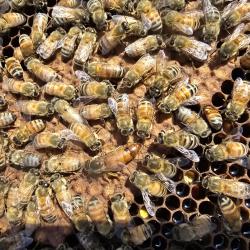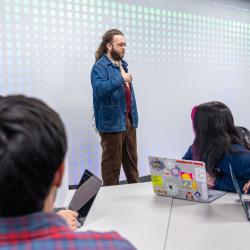Illuminating Science Through Stellar Research and Outreach
Astronomy Ph.D. student Jordan Ealy was recognized by Diverse: Issues in Higher Education for her promising work on the smallest stars in the universe and her efforts to make science more accessible.
University of Maryland astronomy Ph.D. student Jordan Ealy has had a lifelong fascination with the cosmos. Growing up in the San Francisco Bay Area, she spent hours pondering the weather, the sun, the moon, the stars and how they all came to be.

“I always had an interest in science and figuring out how the universe worked. I figured I’d grow up to be someone who could help answer that question, like a meteorologist or an astronomer. My internal career dial kept flipping between these choices for a long time,” Ealy said. “By the time I graduated high school, I took the plunge and decided to go for astronomy. Long story short, I knew I made the right choice after I got my B.A. in astronomy from San Diego State University and I continue to feel that way here at UMD.”
For that fateful decision and all her achievements since, Ealy was named a 2024 Rising Graduate Scholar by national magazine Diverse: Issues in Higher Education. One of only 10 graduate students selected nationwide to receive the honor this year, she was recognized for her community STEM outreach efforts and promising work with Astronomy Assistant Professor Thaddeus Komacek involving low-mass stars (the smallest and faintest stars in the universe) and how they evolve alongside the planets near them. Also known as M dwarfs, low-mass stars make up over 75% of the galaxy’s stellar population and can “live” for trillions of years.
According to Ealy, low-mass stars have extremely high magnetic activity levels and the varying amounts of light they emit from that magnetic activity influence the space around these stars—even creating conditions necessary for life on the planets orbiting them.
“If you were to go outside and look up at the sky—even on the clearest, darkest night—you still wouldn’t be able to see these stars with your bare eyes,” Ealy explained. “But they’re the most common type of star in our galaxy and important for locating rocky exoplanets in space, especially the ones that might have biosignatures. Whether these planets can be habitable or hostile to life is entirely dependent on what its star is doing, similar to how our sun plays a big role in how life on Earth exists.”
Under the guidance of Komacek and NASA Goddard Space Flight Center research astrophysicist Joshua Schlieder, Ealy successfully demonstrated the importance of flaring activity (changes in brightness) in small and young stars, as well as the flares’ potential to affect the atmospheres of companion planets, using data from the Transiting Exoplanet Survey Satellite (TESS).
Komacek, who nominated Ealy for the award, notes that her work both in and out of his lab exemplifies all the traits of a well-rounded scholar.
“Jordan is a true leader in the department and beyond. Her cross-cutting research on characterizing stellar flare activity of small and young stars has already had significant impact, and her efforts to promote astronomy and basic science have also made a difference in the broader community,” Komacek said. “I think Jordan is a rising and highly active star—pun intended—in the field and I’m very excited to see what she’ll do next.”
Bringing science back to the community
For Ealy, the idea that the smallest and faintest stars in the galaxy may hold some of the biggest secrets of the universe is intriguing. It’s also a driving force behind her hope to increase public accessibility to astronomy research.
“My community and my family at home support me with whatever I do. But in academia, there can also be a sense of isolation or separateness that you feel as a researcher,” Ealy explained. “You’re always working toward the next paper or project, thinking that this result will feed into this other thing or that you’ll have to present this finding at this next conference. The science we do rarely gets back to the people who are actually supporting it and funding it.”
Ealy’s passion for science outreach ignited when she participated in a summer undergraduate research experience program hosted by the Maria Mitchell Association, a U.S. National Science Foundation-funded initiative dedicated to inspiring new generations of scientists. There, Ealy conducted research with the organization’s astronomers but also frequently gave presentations for visitors about the research being performed there.
“The experience taught me that it was important to learn how people learn and understand things,” Ealy said. “It’s a philosophy that’s been with me since.”

At UMD, Ealy has already made a difference in science outreach through her activities as co-developer of the Space Sciences Outreach Cooperative, an interdepartmental graduate student-led organization at the university. The group hosts a variety of science outreach events across the campus and the D.C. metropolitan area, including speaking events with the College Park Aviation museum and Prince George’s County library system, contributions to the Eclipse Soundscapes Project (a NASA Citizen Science project studying how eclipses impact life on Earth) and UMD’s recent solar eclipse watch party.
Ealy believes these activities help introduce complex sciences to the general public, allow the community to have a more hands-on approach to research and help people better understand the universe around them.
“Here we are, making all sorts of discoveries that give us insight into life-changing stuff, and few people outside of the science community know about it,” Ealy said. “I want to change that and make sure the science we do is reaching the people around us and returning back into the world.”







